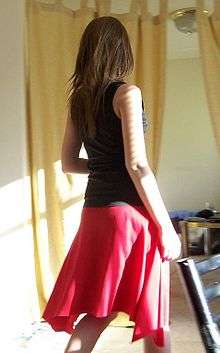Handkerchief skirt
Handkerchief skirts are skirts with asymmetric hems, created from fabric panels of different lengths sewn together, to create a hem with several corners that hang down as points. The hem resembles a handkerchief that is held by the centre so that its corners hang down as points.

History
Handkerchief hems have been used in women's tops and skirt hems for centuries in many cultures, to add a flattering drape, especially over the hips. They can be seen in women's clothing in art from Ancient Greece, and appeared in Parisian fashions in the 1910s-1920s, such as the dresses of designer Madeleine Vionnet.[1] Jean Patou followed Vionnet's lead, using the handkerchief hem to transition hemlines away from the shorter Flapper styles he had helped popularize, and towards the longer lengths that were fashionable during the 1930s.[2]
In the simplest design, a square of fabric is cut with an opening in the middle for the waistband. When the skirt is put on, the four corners hang down as points. More panels of material can be used to increase the number of corners, or points, along the hem.[3]
Revival
In the first decade of the 21st century, handkerchief hems returned as a trend in women's clothing. Since the design involves pleats that drape, the effect is achieved with lightweight, flowing fabrics. In 2003, the trend was evident in bohemian styles such as designs by American clothing label Free People.[4] In 2004, handkerchief hems were modelled at Milan fashion shows.[5]
References
- Kirke, Betty (1998). Madeleine Vionnet. Chronicle Books. p. 18.
- Brockman, Helen (1965). The Theory of Fashion Design,. New York: John Wiley and Sons. pp. 40–52. ISBN 0471105864.
- McKelvey, Kathryn (2006). Fashion Source Book. John Wiley & Sons. pp. 204. ISBN 9781405126939.
- Good Housekeeping. Hearst Corp. 236: 230. 2003. Missing or empty
|title=(help) - JET. Johnson Publishing. 106 (22): 17. 29 November 2004. ISSN 0021-5996. Missing or empty
|title=(help)